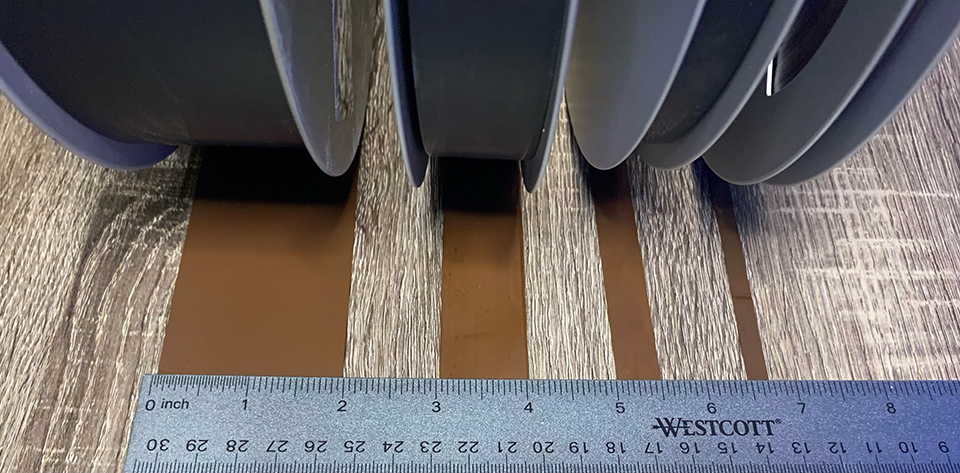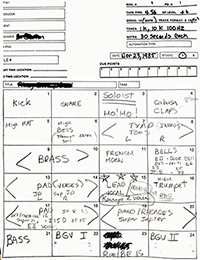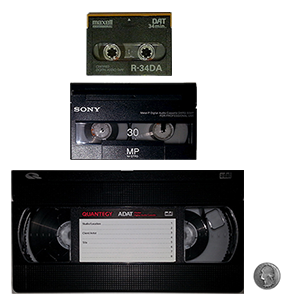Tape Transfer FAQ
What type of audio tape do I have?
There are three broad categories of tapes: audio, video and data. From there we have the form factors of either open reel or cassette. With audio tapes you might know whether they recorded at a studio or on a home stereo. We need to understand these types of details to understand what kind of tape you have so we can tell you if we can transfer it. We hope this guide will help you figure out what kind of tape you have. You can always send us a photo.
Open reel tapes

From left to right: 2 inch, 1 inch, 1/2 inch and 1/4 inch reel to reel tape comparison with a U.S. customary units ruler.
These types of tapes are brown plastic strand on a flat, round spool that might come unwound when you handle them. For audio, many home stereos in the 60s and 70s had 1/4 reel to reel tape player/recorder, so if you have tapes that you know were used with home stereos during this time, this is the type of tape. 1/4 inch open reel were popular before cassettes took over to record things like the radio, records, other tapes, or dictation into a microphone.

If you know the audio tapes are studio master tapes they could be 1/4 inch, 1/2 inch, 1 inch or 2 inch. Just lay the reel flat and measure the height with a ruler. 1/4 inch tapes are typically stereo/2 track mixes but they could also be 4 tracks. Tapes wider than 1/4 inch such as 1/2 inch, 1 inch and 2 inch could have 4, 8, 16, or 24 tracks. They will include a track sheet which details which instruments are on which tracks. They are typically represented by a grid of boxes with the track name written inside. The number of boxes with something written in them will tell you the type of tape machine that was used to record the tapes: 4, 8, 16, or 24 track tape machines. We will need to know which track configuration your tapes are in (what type of machine was used) so we can load them on to the correct type of machine. This has nothing to do with the number of songs. If you have a track sheet, send it with the tape to help us out. The tape's model number, length, and serial number printed on the tape box is inconsequential. Please understand that:
- A 1/4 inch tape could have been recorded with a 2 track, 4 track or 8 track tape recording machine.
- A 1/2 inch tape could have been recorded with a 2 track, 4 track or 8 track or 16 track tape recording machine.
- A 1 inch tape could have been recorded with an 8 track, 16 or 24 track tape recording machine.
- A 2 inch tape could have been recorded with a 16 or 24 track machine.
Helping us understand what you have before we receive it will allow for your reel to reel tape transfer to happen more efficiently.

From left to right: 10 1/2 inch, 7 inch, and 5 inch empty tape reels. The larger the diameter, the longer recording time. 5 and 7 inch reels are usually used only for 1/4 inch tapes.
Cassette tapes

A cassette is two reels inside of a plastic case with a window on it, such as an audio cassette, the kind which the player was standard in most car stereos from the 80's to early 2000's. ADAT tapes are also cassettes, just larger, which are the same as SVHS video tapes. The other digital audio cassette formats are DAT tapes and DTRS tapes (pictured, right). 8 track tape cartridges are another cased tape format that was popular for car stereos in the 60s and 70s. 8 Track tape cartridges contain 1/4 inch tape but with a special head configuration.
What is a two track or a multitrack recording?
We have a full article all about two track and multitrack recordings.
Can you record on both sides of an open reel tape?
If the tape is 1/4 inch and the box has labeling written on it that indicates side A and side B or side 1 and side 2 then it is a double sided tape. We can transfer these types of tapes to digital files. These tend to be 7 or 5 inches in diameter.
Can we transfer open reel video tapes?
We do not work with open reel video tapes, only some video cassette tapes.
Can you transfer an audio tape to a CDR?
Yes, it is possible for us to record the audio we transfer from your tapes to CDR but it may be more advantageous to have it delivered as a .wav file. CDRs have a lifespan of about 20 years and they may eventually suffer from data rot. A .wav file can be stored on a computer or a USB flash drive, or in the cloud. As long as you are able to copy the files from one computer to the next as you upgrade or keep a regular backup routine your files should survive on a hard drive or flash storage for as long as you need it.Do you buy gear?
Yes, we are always looking for tape machines, synthesizers, keyboards, drum machines, samplers, digital recorders, effects units, and home organs. We may even take them as a trade for tape transfers.
Can you transfer my multitrack tape to a CDR?
If you have a multi track tape that you would like transferred to a CD it will need to be mixed. Many clients that request multitrack tape transfers are mixing the tracks on their own in a digital audio workstation (DAW) such as Pro Tools, Logic, GarageBand, Cubase, Nuendo or FL Studio since mixing is a highly subjective art. However, we do provide mixing services. We can provide a quote on mixing once we have completed the transfer and are able to evaluate the material.
Can I save in audio transfer costs by selecting a lower resolution file like MP3?
It does not save us any time or labor to record media in lower resolutions. We will always use 44.1Khz, 16 bit as the minimum sampling frequency and bit rate when we archive audio material. We can go higher, and we can make the audio available as MP3 files at no additional cost. But we can’t record as MP3 format during the final archival stage to save resources. The process does not work this way.
Will my audio tape be ruined if I try to play it?
If the tape has sticky shed syndrome it could get ruined if it is not baked. If the tape was used in a pro studio to record a mix down or multitrack then it might be on professional tape such as Ampex or Quantegy. These formulas of tape need to be baked to make the glue that holds the magnetic particles to the tape so they are stable again. Once baked they are no longer sticky and will glide across the tape heads and not be permanently damaged. Most Scotch and 3M brand tapes used an acetate formula with silicon coating and will be ruined it they are baked. We don't bake these types of tapes. If the box or reel has the Scotch and 3M brand name on it then it is safe to assume it is actually that it acetate formula with silicon coating. However, there is a small chance that it could be a sticky tape on a Scotch or 3M reel or box. We can determine if this is the what has happened by examining the tape. Don't try it yourself, it needs be be at a temperature lower most conventional ovens are unable to go down to. If you bake them and the temperature is too high you will ruin the tape and your recordings are lost forever. We have experience baking hundreds of tapes.
I have a tape reel that looks like this

Tape without a metal reel is called a "pancake". We can deal with pancakes for an additional fee.
Does baking affect the sound quality?
For tape formulas that require baking this process does not harm the tape physically or degrade the sound quality. The most important part about baking is that it makes the tape playable again so we can archive it and you can listen to it, release it commercially, and/or mix it.
Can or should digital tapes be baked?
Digital tape formulas are different than the unstable analog tape formulas. They should never be baked.
My tape has white stuff on it. What is this?

This is a tape with mold growing on it. We can remove the mold from tapes for an additional fee, which will need to be done prior to the transfer.
I have a DAT that says DDS on it. Is this an audio tape?
It is a Digital Data System tape. It is a special DAT tape used to store computer data. If you ever recall using a tape backup for your audio recording sessions for music, your files could be on this tape. These were used by audio recording studios from the mid 90s to early 2000 to store DAW sessions like Pro Tools. However, they can be recorded and played back on DAT machines but the tape is much thinner so there is a small possibility of the deck "eating" the tape. Learn more about are DDS transfer services.
What sample frequency and bit rate should I have you record my analog tape?
CDs are at 44.1kHz, 16 bit, but is it very easy for today's computers to deal with higher frequencies and rates. Currently the industry standard is 48kHz, 24bit. If you choose this you will be able to record to a CD or use for streaming services. Learn more.
Why Choose Deep Signal Studios?
